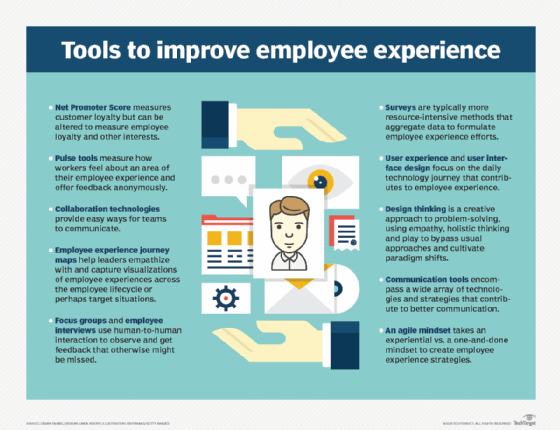
Getty Images
7 employee experience stats to reshape your EX strategy
Businesses that invest in their employees and provide exceptional EX are more successful than their counterparts that don’t.
Employees are the first customers for any business, so it’s just as important to provide a great experience for employees as it is customers.
Employee experience (EX) is the journey a worker takes with his or her company. This journey includes every interaction the employee has with a particular employer -- from job candidacy to leaving the company. Important components of the employee experience include the organization’s physical workspace, corporate culture, technology and employee well-being.
Here are seven statistics showing the importance of a positive employee experience.
1. Engaged employees show up to the job and do more work
Businesses with engaged employees see a 41% reduction in absenteeism and a 17% increase in employee productivity, according to Gallup's "State of the American Workplace" report.
Engaged, happy employees provide better service to customers and the company as a whole, the report noted. And since engaged employees are productive and on the job more than disengaged employees, they are more familiar with customer needs.
2. Work-life balance is important to the employee experience
Approximately 87% of employees expect their employers to support a healthy work-life balance, according to a survey from Glassdoor.
A good work-life balance provides benefits for employees and businesses. A healthy balance can actually increase employee performance, as it motivates employees to increase their workloads.
For example, encouraging employees to take breaks during the day will give them time to take care of personal business, such as making doctor appointments and checking personal email -- tasks that they won't have to do when they're supposed to be working.
3. Well-being drives employee performance
Many organizations view well-being as a business performance strategy as well as an employee benefit, according to Deloitte's "2018 Global Human Capital Trends" survey.
In fact, 60% of surveyed employees said well-being enhances employee retention, and 61% said it improves employee productivity and bottom-line business results.
Moreover, CareerBuilder's survey on stress in the workplace found that 61% of employees feel burned out on the job, while 31% reported high levels of stress.
Depression, sleepless nights and anger issues are among the stress-related symptoms workers said they've experienced. Stress also affects job satisfaction: Roughly 33% of workers with high stress levels said they are dissatisfied with their jobs, according to CareerBuilder.
Some of the reasons for employee stress include the following:
- being asked to complete tasks for which they aren't equipped;
- lack of support from colleagues and managers;
- unrealistic expectations;
- heavy workloads; and
- fast-approaching deadlines.
To ease stress, managers can loosen deadlines and meet with their employees to help them prioritize their work. Many companies have also improved their physical environments to encourage healthy behaviors, such as stocking break rooms with healthy food, and installing appropriate lighting and ergonomic workstations.

4. Recognition is tied to performance
Approximately 92% of workers said that when they're recognized for specific tasks, they're more likely to do them again in the future, according to the "2020 Engagement and Retention" report from Achievers Solutions Inc. Recognition makes employees feel appreciated and motivates them to work harder.
Lack of recognition, on the other hand, is the third most common reason employees choose to leave their jobs -- with the two most common reasons for leaving a job being compensation and career advancement.
While many employees think they're doing their jobs well, they may not feel that management really appreciates their work. One way to address this issue is for employers to use internal social media to strengthen relationships with employees by posting positive reviews of their projects.
5. Disengaged employees cost businesses money
Disengaged employees cost organizations an estimated $450 billion to $550 billion every year in the United States, according to a report by The Engagement Institute.
Approximately 95% of workers said they know when they're becoming disengaged, which is usually due to a lack of compelling business goals, trusted relationships and well-designed jobs.
To engage employees, managers should connect employees' work to business objectives, recognize contributions and promote an environment of collaboration. Communication is also key to a healthy, engaging company culture.
6. Showing empathy improves employee retention
More than 90% of employees, HR professionals and CEOs said it's important for their companies to demonstrate empathy, as reported in the "2020 State of Workplace Empathy" study from Businessolver Inc. However, while 91% of CEOs said their organizations are empathetic, only 68% of employees said the same -- emphasizing the gap between business leaders and their employees.
Moreover, 83% of employees would consider leaving their current companies for similar roles at organizations that are more empathetic.
One way for organizations to demonstrate empathy is through the benefits they offer. More than 90% of workers emphasized the importance of an employer that offers family leave benefits -- such as maternity and paternity leave, bereavement and time to care for sick family members.
7. Bank employees believe AI will make their jobs more interesting
Technology can also help improve the employee experience. Approximately 61% of bank employees said introducing artificial intelligence would make their jobs more interesting, and 67% said AI would create more opportunities for them, according to a report from Accenture.
Moreover, the report found banks that invest in AI could boost their employment levels by 14%.
In fact, 67% of banking executives expect AI to result in a net gain in jobs within their bank by 2022, and more than two-thirds of bank employees said AI would improve their work and work-life balance.








